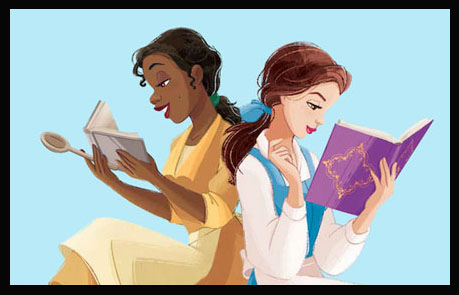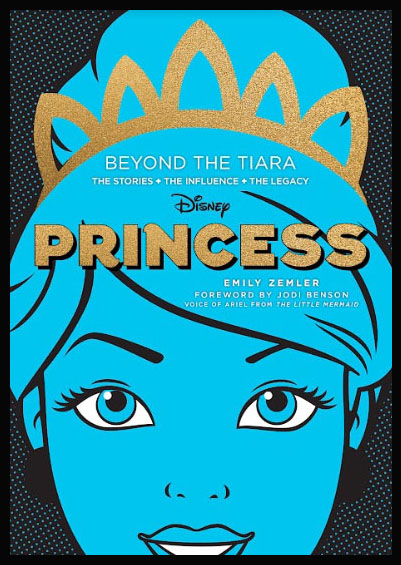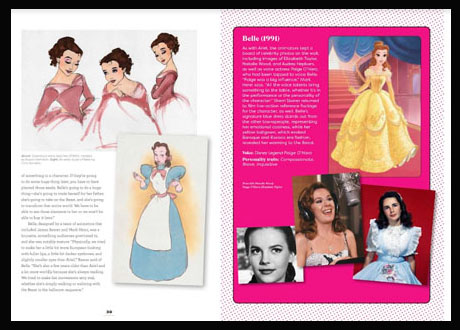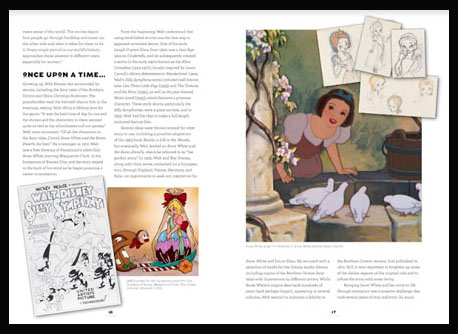
A new book on some of the most iconic Mouse House characters is a must-own for Disney fans. Disney Princess: Beyond the Tiara — The Stories. The Influence. The Legacy. is available Tuesday September 20th. Author Emily Zemler (The Art and Making of Aladdin) takes me under the sea and on a magic carpet ride through the process of writing this fantastic, in-depth book, from the research and interviews to the ways these princesses have changed (more than just a part of) our world. (This Animation Scoop Q&A was edited for length and clarity.)
Jackson Murphy: So many iconic Disney movies, especially the Princess films, are about dreams. How is this book a dream come true for you?
Emily Zemler: Someone comes to you and says, “Do you wanna write a book about the Disney Princesses?” you think, “Are you sure? Is that a job someone actually gets as an adult?” It was really a dream — both to get to write the book and also to delve into all these subjects. When I was approached to do this, it was a very short little not-even [one] paragraph idea, and then it was up to me to flesh out what it would look like. What do we wanna know about these characters and these stories? That was really fun to get to figure them out. What don’t audiences know about them? What hasn’t been investigated?

JM: In your research, did you go back and watch these movies more thoroughly than you ever had before? How was that experience?
EZ: It was great. When I got the go-ahead to work on the book, that was the first thing I needed to do: re-watch the films and watch every iteration of the Disney Princesses as they have appeared on screen for the last several decades. That was a lot. But it was really interesting to re-visit films that I hadn’t seen in a long time, especially as an adult. I was born in ’83, so I grew-up with the films of the Disney Renaissance being really impactful. Getting to re-watch stuff like The Little Mermaid, Aladdin and Mulan — it was really interesting and gratifying to realize these things that had such an impact on me growing up continue to have that same impact and were just as good as they were back then. There’s a reason they’ve sustained for so long.

Emily Zemler
EZ: It’s an absolute masterpiece. The best part about researching Beauty and the Beast was speaking with Linda Woolverton, who was the screenwriter of the film, and then she went on to write the stage production that went to Broadway. She’s absolutely wonderful. She was one of the first interviews I did for the book.
Hearing her talk about the way she wanted to make Belle feel intelligent and relatable… and she really wanted Belle to be a reader. She was inspired by Meg from Little Women. At the time… Ariel had been a pretty feisty, go get it yourself hero but she wasn’t quite there in terms of empowerment. And then we got Belle, who was this really intelligent, wanted to have an adventure woman. Because audiences responded so strongly to Belle and she was so popular (and especially because she had brown hair, which we hadn’t really seen in a Disney Princess) they went on to change Jasmine in Aladdin to make her more empowered and to give her more feistiness, relatability and sense of adventure.

JM: I recently spoke with Brave co-director Steve Purcell. He loved bringing the character to life and helping Kelly MacDonald find the ‘tone of voice and kind of attitude that teenagers have’. What do you love the most about Merida?
EZ: I love Merida. She was so important because at the time we had gotten all these amazing Pixar films and they’ve been really groundbreaking with emotional stories, but we hadn’t had a female protagonist. As a woman, that felt like a lack. You wanna be able to see yourself on screen and can relate to the heroes presented to you. When Brave was announced, I was so excited. It was such a great idea to subvert that princess / fairy tale story in a new way. Merida is important because she has really strong and important qualities to her but she also is fallible. She makes a really big mistake and she has to own up to that mistake. That’s a really important thing for young people to get to see on screen. You have to rectify those mistakes, and in doing that, Merida gets this amazing reconciliation with her mother. We also hadn’t seen that in a Disney or Pixar film: many of the Princesses don’t have positive relationships with their mother figures. Getting to see that was a really key moment for a lot of viewers.
JM: The Disney Princess group is a franchise that has meant so much to so many. How do you feel this collective group impacts the Disney brand of today and this generation’s kids?
EZ: It’s a franchise. It was created by what was called Disney Consumer Products — to help these characters come together. Prior to 2000, the characters existed separately. We would’ve never seen them interact. There would never have been a lot of merchandise, except when the films were coming out. This allowed the characters to interact with each other and share their stories and to be part of branding collectively. What that does is brings the audience together with the Princesses. You’re part of this group of friends who are all supporting each other. That’s been really impactful on the way they’re presented.
Today they’re presented differently than they were historically. Each Disney Princess is a reflection of the time at which she was made. The values that are presented on screen reflect the values of that era rather than the values that we hold today. By continuing this franchise and refreshing these characters, Disney has been able to keep them current and let them feel modern. The thing that unites them is that sense of adventure… and curiosity and courageousness and kindness. We can all relate to that, and it has a big impact on young women who get to see characters who go out into the world and embrace their own story.

JM: How do you feel the recent live-action versions of some of these movies have changed the perception of these princesses?
EZ: The Walt Disney Studios live-action reimaginings… have enabled us to bring these characters who were created in specific eras with specific values into a more present and modern experience. It doesn’t mean you’re taking Cinderella and putting her story in modern day, but it does mean that you are presenting her through modern-day values. They’ve allowed us to impart what we believe female characters should be into the stories. More recent ones, like the upcoming Little Mermaid and Snow White adaptations, have more diverse and inclusive castings. The characters tend to be more overtly feminist. They tend to reflect what we’re interested in and what we’re embracing today. That has been a way for The Walt Disney Studios to take beloved characters we grew up with and give them a sort of more contemporary look.
JM: I love the 2015 Kenneth Branagh Cinderella: the costumes, Lily James, Cate Blanchett — so good. The insights Jodi Benson brings in the foreword are fantastic (press tour/yearning for something more). What does it mean to you that she was able to provide this for your book?
EZ: It means a lot. She sounds like Ariel. Her voice sounds like that. You’re speaking with someone on the phone and they sound like this character you watched on screen over and over again when you were a child. That is a really strange and wonderful feeling to have. We always wanted it to be Jodi. That was my pick from early on. She was the right voice to open this book. The reader of this book is someone who grew-up loving Disney. This is a book for adults, and that means someone who maybe grew-up in the ’80s or the ’90s or the 2000s and loved those films of the Disney Renaissance. Jodi is the voice of that. It was wonderful to hear her stories. Her quotes in the book are quite short. We spoke for over an hour. I have a lot of stuff from her that’s not used that will just belong to her and I.
JM: That’s amazing. What are your favorite Disney Princess toys/collectibles you have?
EZ: Growing up I had all the Mattel Barbie dolls of the Disney Princesses. I had a Jasmine and an Aladdin doll. They were really amazing. I had a lot of Little Mermaid stuff. I had a Pocahontas Barbie. Unfortunately, about 12 years ago my parents’ house was lost in a forest fire, so all of my childhood toys and collectibles burned up. Currently, the only Disney Princess memorabilia in my house is this book that I wrote.

JM: So sorry to hear that, but at least you have the memories, and they carry you through into this book. You mention at the beginning that you always wanted to speak with animals. If you could have a conversation with any of the animal friends of the princesses, who would it be?
EZ: That’s a very challenging question. I have to say Rajah. I had a stuffed Rajah. I love the Jasmine / Rajah relationship. Wouldn’t you love to have a tiger that followed you around and knew your emotional state and was there to support you?
JM: Great choice. I think I’d go with Pascal from Tangled. What’s your fondest memory of seeing one of these Disney Princess films on the big screen?
EZ: I remember seeing most of them when I was a kid. I grew-up in Boulder, CO and we would go to the local theater next to Safeway. I remember seeing Pocohantas on the day it opened. My strongest, but maybe not my fondest, memory was going to see Sleeping Beauty with the re-issue in theaters. I was so scared when Maleficent turned into a dragon that I had to be taken out of the theater. That goes to show you how powerful that animation really was.
- INTERVIEW: Strap In For “Mars Express” - April 30, 2024
- INTERVIEW: Jeff Fowler On “Knuckles” And “Sonic 3” - April 22, 2024
- INTERVIEW: “Inside Out 2” Director And Producer On Pixar Sequel - April 16, 2024


 September 8th, 2022
September 8th, 2022  Jackson Murphy
Jackson Murphy  Posted in
Posted in  Tags:
Tags: 






